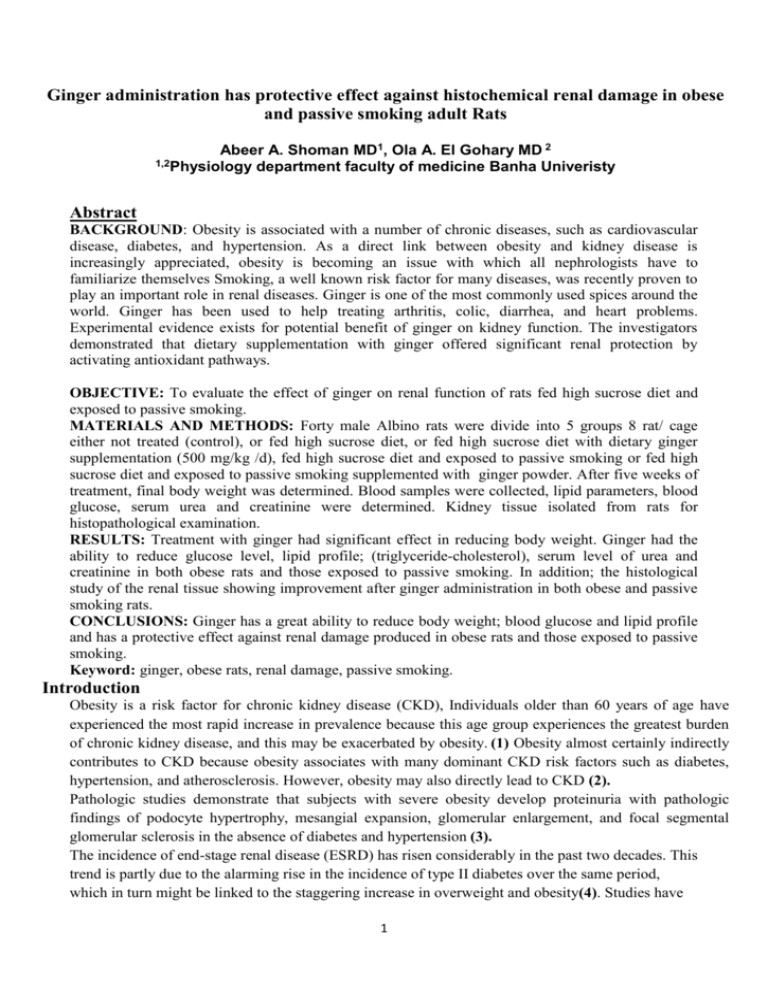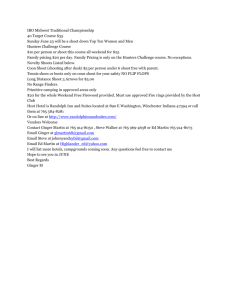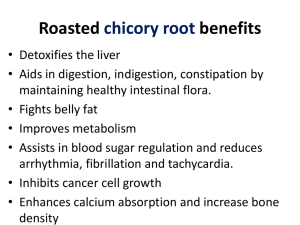
Ginger administration has protective effect against histochemical renal damage in obese
and passive smoking adult Rats
Abeer A. Shoman MD1, Ola A. El Gohary MD 2
1,2Physiology department faculty of medicine Banha Univeristy
Abstract
BACKGROUND: Obesity is associated with a number of chronic diseases, such as cardiovascular
disease, diabetes, and hypertension. As a direct link between obesity and kidney disease is
increasingly appreciated, obesity is becoming an issue with which all nephrologists have to
familiarize themselves Smoking, a well known risk factor for many diseases, was recently proven to
play an important role in renal diseases. Ginger is one of the most commonly used spices around the
world. Ginger has been used to help treating arthritis, colic, diarrhea, and heart problems.
Experimental evidence exists for potential benefit of ginger on kidney function. The investigators
demonstrated that dietary supplementation with ginger offered significant renal protection by
activating antioxidant pathways.
OBJECTIVE: To evaluate the effect of ginger on renal function of rats fed high sucrose diet and
exposed to passive smoking.
MATERIALS AND METHODS: Forty male Albino rats were divide into 5 groups 8 rat/ cage
either not treated (control), or fed high sucrose diet, or fed high sucrose diet with dietary ginger
supplementation (500 mg/kg /d), fed high sucrose diet and exposed to passive smoking or fed high
sucrose diet and exposed to passive smoking supplemented with ginger powder. After five weeks of
treatment, final body weight was determined. Blood samples were collected, lipid parameters, blood
glucose, serum urea and creatinine were determined. Kidney tissue isolated from rats for
histopathological examination.
RESULTS: Treatment with ginger had significant effect in reducing body weight. Ginger had the
ability to reduce glucose level, lipid profile; (triglyceride-cholesterol), serum level of urea and
creatinine in both obese rats and those exposed to passive smoking. In addition; the histological
study of the renal tissue showing improvement after ginger administration in both obese and passive
smoking rats.
CONCLUSIONS: Ginger has a great ability to reduce body weight; blood glucose and lipid profile
and has a protective effect against renal damage produced in obese rats and those exposed to passive
smoking.
Keyword: ginger, obese rats, renal damage, passive smoking.
Introduction
Obesity is a risk factor for chronic kidney disease (CKD), Individuals older than 60 years of age have
experienced the most rapid increase in prevalence because this age group experiences the greatest burden
of chronic kidney disease, and this may be exacerbated by obesity. (1) Obesity almost certainly indirectly
contributes to CKD because obesity associates with many dominant CKD risk factors such as diabetes,
hypertension, and atherosclerosis. However, obesity may also directly lead to CKD (2).
Pathologic studies demonstrate that subjects with severe obesity develop proteinuria with pathologic
findings of podocyte hypertrophy, mesangial expansion, glomerular enlargement, and focal segmental
glomerular sclerosis in the absence of diabetes and hypertension (3).
The incidence of end-stage renal disease (ESRD) has risen considerably in the past two decades. This
trend is partly due to the alarming rise in the incidence of type II diabetes over the same period,
which in turn might be linked to the staggering increase in overweight and obesity(4). Studies have
1
indicated that a growing body of evidence suggests that in genetically obese animals, food restriction
can prevent or greatly delay the onset of specific degenerative lesions, in particular
glomerulonephritis associated with obesity and diabetes (5).
Ginger is an aromatic root that has a strong flavor. It is used in recipes to add a spicy and sweet
flavor and is very common in Asian cooking. Ginger can be found in the whole root form, as ginger
powder, and is available in teas and ginger ale. Historically, ginger was used as a food preservative
and as a remedy for indigestion. It is still used today to help treat nausea (6).
Ginger may be effective in stimulating weight loss in obese men and women. According to the
National Kidney Foundation, more than 20 million Americans have chronic kidney disease; Current
therapies may offer some benefit in slowing the progression of chronic kidney disease, but most
patients ultimately end up with kidney failure. You may be tempted to try alternative therapies such
as Ginger (7).
Smoking, a well known risk factor for many diseases, was recently proven to play an important role in
renal diseases. Studies showed that cigarette smoking is a risk factor for the development and progression
of chronic kidney disease (CKD) in community Smoking significantly increases the risk of CKD When
compared to nonsmokers (8). One study revealed that men who smoked were three times more likely to
have reduced kidney function as compared to male non-smokers,
One of the ways smoking damages kidney function is by affecting the blood flow within the body.
Smoking hardens the arteries and narrows the blood vessels, which can restrict blood flow to the kidneys
and cause them to be less efficient (9).
A study in "Renal Failure" in April 2004 examined whether ginger could preserve kidney function
following ischemia. The investigators demonstrated that dietary supplementation with ginger offered
significant renal protection by activating antioxidant pathways (10).
Materials and Methods
Animals
Six-wk-old male rats were housed in the Banha University Animal in plastic cages 40 adult male
albino rats; 8rats/cage, weighing 220-250 g, at room temperature of 25±2°C. Rats were allowed to
acclimate to this facility for 1 wk prior to entry into an experimental study. Rats were given standard
and modified diet and free access to water.
Composition of the diets used.
Standard chow diet:
- The fat represented 4% of the total caloric requirement.
- The carbohydrates represented 44% carbohydrate (41 % starch and 3% sucrose) of the total caloric
requirement.
- The protein represented 23% of the total caloric requirement.
- The fibers represent 14% of the total caloric requirement (11).
High sucrose diet:
- The fat represented 6% of the total caloric requirement.
- The carbohydrates 49.5% (4.5% starch and 47% sucrose) of the total caloric requirement.
- The protein represented 24% of the total caloric requirement.
- The fibers represent 9% of the total caloric requirement.
- The high-sucrose diet was obtained mixing 600 g sucrose and 60 g of soy oil to 1000 g of a
previously triturated standard chow. Casein was
added to achieve the same protein content as the
standard chow (12).
2
The rat were divided into 5 groups
Group I (control group): serves as control group, they received standard diet in which sucrose
represents 3% of the total caloric requirement for 5 weeks and kept sedentary (untrained) until the end
of the experiment.
Group II (High Sucrose not exposed to passive smoking) HS group: rats that received 47 % sucrose
in diet for 5 weeks and kept sedentary until the end of the experiment.
Group III (High Sucrose exposed to passive smoking) HSS group: that received 47 % sucrose in diet
for 5 weeks and exposed to 6 cigarettes/day, 5 days/week for the last 4 weeks.
Group IV (High Sucrose not exposed to passive smoking with ginger administration HSG group):
that received 47 % sucrose in diet and ginger powder was administrated in a dose 500 mg/kg by a
gavage method for 5 weeks(13).
Group V: (High Sucrose exposed to passive smoking with ginger administration) HSSG group: that
received 47 % sucrose in diet and ginger powder was administrated in a dose 500 mg/kg by a gavage
method for 5 weeks and exposed to 6 cigarettes/day, 5 days/week for the last 4 weeks before taking
samples.
Assessment of Obesity:
After 5 weeks of dietary treatments, the animals were anaesthetized (0.1ml intra peritoneal of 1%
Thiopental Na) for the measurement of body length (nose-to-anus or nose-anal length). The body
weight and body length were used to confirm the obesity through the obesity parameters body mass
index (body weight g/ length cm2).
Exposure to passive smoking:
9 rats were divided into 3 groups the 1st group was exposed to 2cigarettes/day, the 2nd group was
exposed to 4 cigarettes/day and the 3rd group was exposed to 6 cigarettes/day. All groups were exposed
to passive smoking for 5 days/week for 4 weeks. At the end of the duration all rats were examined for
serum urea and creatinine. The most effective dose was 6 cigarettes/day.
3.5
3
2.5
2
1.5
1
0.5
0
2 cigarettes
4 cigarettes
6 cigarettes
Chemical analysis
At the end of the experimental period the rats were anaesthetized after 12 hour fasting by inhalation
of diethyl ether. Blood samples were collected by intracardiac suction for serum separation, for the
determination of urea (BUN) and creatinine level, fasting glucose, triglyceride, total cholesterol
serum levels. These were investigated in Banha faculty of medicine at biochemistry analysis unit.
Pathological evaluation
A histological study was performed following a midline laparotomy to remove the kidneys. The
kidneys were dissected and fixed in 10% formalin solution at room temperature. An experienced
pathologist evaluated all samples. All fields in each section were examined and graded for necroinflammation.
3
Statistical Analysis:
All data were expressed as mean S.D; data were evaluated by the one way analysis of variance.
The calculations were performed by SPSS program version 17. Difference between groups were
compared by Student's t-test with P 0.05 selected as the level of statistical significance.
Results:
Blood biochemical parameters
Levels of Serum glucose, urea, creatinine and lipid profile (Triglycerides, Total cholesterol) and body
weight index (BWI) measured in all groups are shown in Table 1. The serum level of glucose, urea,
creatinine, triglycerides, total cholesterol and the body mass index were significantly increased in
group II that received high sucrose diet in comparison to control group. The serum level of glucose,
urea, creatinine, and triglycerides, total cholesterol were significantly decreased in ginger administrated
group III in comparison to high sucrose group. High Sucrose group IV exposed to smoking showed
significant increase in serum level of glucose, urea, creatinine, triglycerides, total cholesterol, and the
body mass index in comparison to group of high sucrose not exposed to smoking. The serum level of
glucose, urea, creatinine, triglycerides, and total cholesterol were significantly decreased in High
Sucrose ginger administrated group V and exposed to smoking in comparison to High Sucrose group
exposed to smoking.
Serum glucose, urea, creatinine and lipid profile (Triglycerides, Total cholesterol mg/dl) and
body weight index. Results are expressed as the Mean ± SE. n = 8; High Sucrose group not
exposed to smoking =HS, High Sucrose with ginger group=HSG, High Sucrose group exposed to
smoking = HSS, High Sucrose with ginger group and exposed to smoking= HSSG.
Control
HS
HSG
HSS
HSSG
Glucose (mg/dl) 98+1.56
154+1.64*
110+2.25#
171+0.821$
148.5+1.36@
Trigylc. (mg/dl) 99.5+3.8
139.8+3.1*
103.3+4.3#
158+4.4$
136.2+1.55@
T. choles.(mg/dl) 94.8+ 4.9
110.6+4.3*
94.3+3.3#
135+2.66$
114.3+2.38@
urea(mg/dl)
14.8+2.9
39+3.11*
15+3.11#
44.7+3.61$
13.25+2.54@
creatinine(mg/dl) 0.36+.02
2.45+261*
1.32+.29#
3.61+.249$
0.413+.198@
BWI(g/cm2)
0.541+.024
0.87+.037*
0.577+.035#
0.8475+.029$
0.572+0.036@
*Significant difference (p<0.001) compared with normal control.
#Significant difference (p<0.001) compared with High Sucrose group not exposed to smoking.
$ Significant difference (p<0.001) compared with High Sucrose group not exposed to smoking.
@Significant difference (p<0.001) compared with High Sucrose group exposed to smoking
Histological examination
Group 1 (control group): The histological appearance of the kidney in the control group was normal.
Light microscopic examination of the control group stained by H&E revealed that, the kidney showed
the normal characteristic renal tissue. Normal renal tubular structure and regular glomeruli (Fig. 1).
Histological examination of group II (HS) revealed appearance of hyaline degeneration of the renal
tubular structure (Fig.2). In group III (HSG) in which rats received ginger their renal tissue appeared
nearly normal with mild hyaline changes in the tubular structure (Fig.3). The histological appearance in
group IV (HSS) showed renal damage in the form of tubular necrosis, interstitial hemorrhage and
glomerular vascular damage (Fig.4). This damage was improved in group V (HSSG) in which the
histological examination renealed moderate tubuar damage and glomerular proliferation (Fig.5).
4
Fig.1: normal renal tissue (control group) HE X200
Fig.2: hydropic degeneration of the renal tissue (HS group)
HE X200
Fig.4: Tubular necrosis, interstitial hemorrhage
& glomerular vascular damage (HSS) group HEX200
Fig.3: normal renal tissue with mild hydropic changes
(HSG) groupHEX200
Fig.5: moderate tubular damage & glomerular
proliferation (HSSG) group HEX200
5
Discussion
Ginger was used as a food preservative and as a remedy for indigestion. It is still used today to
help treat nausea. Ginger has not been found to treat or cure kidney disease, but its benefits
against indigestion and nausea can help dialysis patients who are feeling these symptoms.
Because most dialysis patients are given a strict fluid restriction, natural ginger root and powder
should be used rather than in a liquid form (13). Our results revealed that ginger administration
had significant effect on the kidney function in obese male rats and those exposed to passive
smoking. Our study revealed that high sucrose diet resulted in obesity as evident by the body
weight index. Obesity had significant effect on the renal function this appeared in significant
increase in serum BNU and creatinine in obese rats and in obese rats exposed to passive smoking
compared to the control group. In addition there were histological renal damage appeared in these
groups. Ginger administration caused significant decrease in serum urea and creatinine in obese
and rats exposed to passive smoking. These results are in agree with Experimental evidence exists
for potential benefit of ginger on kidney function. A study in "Renal Failure" in April 2004
examined whether ginger could preserve kidney function following ischemia. Using an animal
model, researchers clamped off the blood flow to the kidneys and then provided ginger as a
dietary supplement to the rats. The investigators demonstrated that dietary supplementation with
ginger offered significant renal protection by activating antioxidant pathways (14). Investigators
using animal models have also demonstrated ginger to provide protection from toxin-mediated
kidney damage as can occur with chemotherapy or alcohol-induced damage; Ginger
administration prevented the acute kidney injury caused by the chemotherapy agents. Another
study published in the “Indian Journal of Experimental Biology” in 2010 demonstrated a similar
benefit of ginger on kidney function following alcohol-induced injury (15). In addition; Ginger
may be effective in stimulating weight loss in obese men and women. Because of ginger's health
benefits, ginger has been useful in correcting certain digestive disorders that can greatly affect the
BMI and cholesterol levels of an individual. Even though there are no current scientific or
medical research on the effects of ginger for weight loss, ginger, which comes in many forms, has
had a positive history of improving overall health and wellness (16). In our study ginger
significantly reduced body weight, the blood glucose and lipid profile compared to obese (high
sucrose diet) rats and those exposed to passive smoking. In agreement; Not only does ginger play
a large role in neutralizing intestinal imbalances but it also inhibits bad cholesterol buildup, or
low-density lipoprotein (LDL), in the body's liver. Ginger helps lower cholesterol by significantly
reducing serum and hepatic cholesterol levels. It slows cholesterol absorption by stimulating the
conversion of cholesterol to bile acids. Consuming ginger can have a profound effect on high
cholesterol levels that are often attributed to obesity among women and men (17). In addition;
Ginger reduces Triglyceride and Cholesterol levels and thus helps in improving cardiovascular
health. It elevates the levels of high density Lipoproteins and lowers the risks of stroke and heart
attack by improving the blood circulation (18).
Other study indicates that raw ginger possesses hypoglycemic, hypocholesterolaemic and
hypolipidaemic potential. Additionally, raw ginger is effective in reversing the diabetic
proteinuria observed in the diabetic rats. Thus, ginger may be of great value in managing the
effects of diabetic complications in human subjects (19). Ginger extract is among the top ten
6
ingredients in weight-loss products. These products are available in many states. It is generally
safe to take and it is believes to have anti-inflammatory and anti-nausea effect (20).More study
revealed that ginger and Arabic gum could be beneficial adjuvant therapy in patients with acute
renal failure and CRF to prevent disease progression and delay the need for renal replacement
therapy(21).
Ingesting pure ginger helps you quit smoking. Ginger has a warming and heating effect in the
body, which promotes perspiration. When your body sweats it excretes toxins and relieves some
chemical loads from the body. A great detox for a smoking addiction. Also - Drink ginger tea.
Instead of smoking try preparing a cup of ginger tea. This is effective because it helps form a new
habit instead of smoking (22).In spite of these benefits we should study accurately the dose and
side effects of ginger as herbal supplements are not regulated by the government and may contain
contaminants and high levels of other substances such as potassium that injured kidneys may not
be able to process. The National Kidney Foundation, in addition to encouraging further research,
recommends that patients with chronic kidney disease discuss taking any herbal supplement, such
as ginger, with their health care provider prior to beginning therapy.
References:
1. Jesse Sulzer, Demand Media: 2013 The Benefits of Ginger to Kidney Function;
WWW.Qginger.com.
2. Mokdad AH, Ford ES, Bowman BA, Dietz WH, Vinicor F, Bales VS, Marks JS:
Prevalence of obesity, diabetes, and obesity-related health risk factors. JAMA 289: 76–79,
2003.
3. Serra A, Romero R, Lopez D, Navarro M, Esteve A, Perez N, Alastrue A, Ariza A
: Renal injury in the extremely obese patients with normal renal function. Kidney Int 73: 947–
955, 2008.
4. Kambham N, Markowitz G, Valeri A, Lin J, D'Agati V: Obesity-related glomerulopathy:
An emerging epidemic. 2001, Kidney Int 59: 1498–1509.
5. American Diabetes Association (1997) Diabetic nephropathy. Diabetes Care 20:24-27.
6. Judith S. Stern, Mathew D. Gades, Carrie M. Wheeldon, and Andrea T. Borchers:
Calorie Restriction in Obesity: Prevention of Kidney Disease in Rodents The American
Society for Nutritional Sciences Nutr. March 1, 2001 vol. 131 no. 3 913S-917S.
7. Amber Wilson Jul 20, 2011, www. Livestrong.com; kidney dialysis.
8. National kidney foundation 2013: Use of herbal supplementation in chronic renal disease
http://www.kidney.org/atoz/content/herbalsupp.cfm.
9. Yamagata K, et al.: Risk factors for chronic kidney disease in a community-based
population: a 10-year follow-up study. Kidney Int 2007, 71(2):159-66.
10. Rabi Yacoub, Habib Habib, Ayham Lahdo, Radwan Al Ali, Leon Varjabedian, George
Atalla, Nader Kassis Akl, Saleem Aldakheel, Saeed Alahdab and Sami Albitar
Association between smoking and chronic kidney disease: a case control study; BMC Public
Health 2010, 10:731 doi:10.1186/1471-2458-10-731.
11. Gisele A. Souza,1 Geovana X. Ebaid,2 Fábio R. F. Seiva,2 Katiucha H. R.
Rocha,1 etal.(2011): N-Acetylcysteine an Allium Plant Compound Improves High-Sucrose
Diet-Induced Obesity and Related Effects. Ecam/nen070. 10.1093-1100.
12. Yoshihisa Takahashi, Yurie Soejima, Toshio Fukusato(2012): Animal models of
nonalcoholic fatty liver disease/ nonalcoholic steatohepatitis .World J Gastroenterol 2012 May
21; 18(19): 2300-2308
13. YourKidneys.com 2009-2011 is powered by DaVita. All rights reserved.
7
14. E. Uz et al, Renal Failure; 2013, The Effect of Dietary Ginger (Zingiber officinals Rosc)
on Renal Ischemia/Reperfusion Injury in Rat Kidneys.
15. Xianglu Rong, Gang Peng, Takuya Suzuki, Qinglin Yang,Johji Yamahara, and Yuhao Li:
2010; A 35-day gavage safety assessment of ginger in rats; Regul Toxicol Pharmacol. Author
manuscript; available in PMC 2010 March.
16. Yoshihisa Takahashi, Yurie Soejima, Toshio Fukusato(2012): Animal models of nonalcoholic
fatty liver disease/ nonalcoholic steatohepatitis .World J Gastroenterol 2012 May 21; 18(19): 23002308.
17. http://www.ehow.com/about_5535350_ginger-weight-loss.2013, html#ixzz2dPBl4lb1
18. Ginger for Weight loss Posted by adamgilicirist on July 8, 2011
19. Al-Amin ZM, Thomson M, Al-Qattan KK, Peltonen-Shalaby R, Ali M; 2006Anti-diabetic
and hypolipidaemic properties of ginger (Zingiber officinale) in streptozotocin-induced
diabetic rats. Department of Biological Sciences, Faculty of Science, Kuwait University,
13060-Safat, Kuwait, Oct;96(4):660-6.
20. Linh H. Nguyen; 2012, Does the Use of Ginger Extract Effectively Help Patient with Obesity
Loses Weight?PCOM Physician Assistant Studies Student Scholarship.
21. Mahmoud MF, Diaai AA, Ahmed F.2012,Evaluation of the efficacy of ginger, Arabic gum,
and Boswellia in acute and chronic renal failure ;34(1):73-82.
22. http://www.naturalcuresnotmedicine.com/2013/05/how-to-use-herbs-to-quitsmoking.html
8






